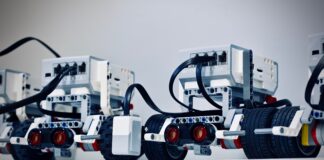Neuromorphic computing is a field of research that aims to develop computer systems that mimic the structure and function of the human brain. This approach is based on the idea that the human brain is an incredibly complex and adaptive system, capable of processing vast amounts of information and performing a wide range of cognitive tasks with remarkable accuracy. By studying the brain’s architecture and function, researchers have been able to develop neuromorphic computing systems that can learn, adapt, and respond to their environment in a way that is similar to the human brain.
Neuromorphic computing has the potential to revolutionize the way we design and build artificial intelligence systems, allowing them to learn from experience, adapt to new situations, and make decisions based on real-time data. For example, a neuromorphic computer could be used to control a self-driving car, allowing it to learn from its experiences and adapt to changing road conditions in real-time. Similarly, a neuromorphic computer could be used to develop a robot that can learn new skills and tasks through trial and error, without the need for explicit programming. In this way, neuromorphic computing has the potential to create a new generation of intelligent machines that are capable of operating in complex, dynamic environments.
Neuromorphic computing is also being used to develop more advanced artificial intelligence systems that can learn and adapt in real-time. For example, researchers have developed neuromorphic computers that can learn to recognize objects and patterns in images and videos, without the need for large amounts of labeled training data. These systems can also be used to develop more sophisticated language processing systems that can understand natural language and generate human-like responses. In addition, neuromorphic computing is being used to develop more advanced robotics systems that can learn from their experiences and adapt to new situations.
One of the key advantages of neuromorphic computing is its ability to process information in parallel, rather than serially. This allows it to handle large amounts of data quickly and efficiently, making it well-suited for applications such as image and video processing. Additionally, neuromorphic computing can be used to develop more energy-efficient systems that use less power than traditional computers.
In recent years, there has been significant progress in the development of neuromorphic computing hardware and software. For example, researchers have developed novel types of transistors called memristors that mimic the behavior of synapses in the brain. These transistors are capable of storing information in a state that is similar to how neurons store memories in the brain. Other researchers have developed neuromorphic algorithms that mimic the behavior of neurons and their connections.
Neuromorphic computing has also been applied in various fields such as autonomous vehicles, healthcare, finance and many other fields where decision making requires adaptive and fast processing. For instance, in autonomous vehicles, neuromorphic computing can enable cars to recognize objects in real-time and make decisions quickly without requiring human intervention. In healthcare, neuromorphic computing can be used for disease diagnosis and treatment planning by analyzing medical images and genomic data.
In finance, neuromorphic computing can be used for fraud detection by analyzing transaction patterns and making predictions about potential fraud. Additionally, neuromorphic computing has been used in various applications such as natural language processing, speech recognition, image recognition and many other areas where machine learning is applied.
The potential applications of neuromorphic computing are vast and varied. It has the potential to revolutionize many industries including healthcare, finance, transportation, education, manufacturing and many others. It can enable machines to learn from experience, adapt to new situations, make decisions quickly and accurately and operate autonomously.
Neuromorphic computing is not without its challenges, however. One of the main challenges is the complexity of the human brain, which is still not fully understood. The brain is made up of billions of neurons, each with thousands of synapses, and the interactions between these neurons are incredibly complex. Developing algorithms and hardware that can mimic this complexity is a significant challenge.
Another challenge is the need for large amounts of data to train neuromorphic systems. Unlike traditional machine learning algorithms, which can be trained on small datasets, neuromorphic systems require vast amounts of data to learn and adapt. This can be a challenge in fields where data is limited or difficult to collect.
Despite these challenges, researchers are making rapid progress in developing neuromorphic computing systems. One area of research is focused on developing novel types of computer chips that mimic the structure and function of the brain. For example, researchers have developed chips that use memristors, which are devices that can store information in a way that is similar to how neurons store memories in the brain.
Another area of research is focused on developing novel algorithms that can mimic the behavior of the brain. For example, researchers have developed algorithms that can learn from experience and adapt to new situations in a way that is similar to how humans learn and adapt.
Neuromorphic computing has also been applied in various fields such as robotics, autonomous vehicles, healthcare, finance and many other fields where decision making requires adaptive and fast processing. For instance, in robotics, neuromorphic computing can enable robots to learn from their experiences and adapt to new situations without requiring explicit programming.
In addition to these applications, neuromorphic computing has also been used in various areas such as image recognition, speech recognition, natural language processing and many other areas where machine learning is applied.
The development of neuromorphic computing is also being driven by advancements in neuroscience and our understanding of how the brain works. By studying the brain’s neural networks and how they process information, researchers are able to develop more accurate models of how the brain works and how it can be replicated in computers.
Furthermore, neuromorphic computing has also been used in various areas such as neuroscience research, education and training. For instance, neuromorphic computing can be used to simulate brain activity and study neurological disorders such as Alzheimer’s disease.
In terms of its potential impact on society, neuromorphic computing has the potential to revolutionize many areas of our lives. For instance, it could enable self-driving cars to learn from their experiences and adapt to new situations without requiring human intervention. It could also enable robots to learn new skills and tasks through trial and error without requiring explicit programming.
Neuromorphic computing has also been used in various areas such as finance, healthcare and education. For instance, it could be used to develop more accurate predictive models for stock market trends or disease diagnosis.
In conclusion: Neuromorphic computing is a rapidly growing field that has the potential to revolutionize many areas of our lives. By mimicking the structure and function of the human brain, neuromorphic computers can learn from experience, adapt to new situations, make decisions based on real-time data and operate autonomously. As research continues to advance in this field, we can expect to see even more exciting applications and innovations emerge.
However, there are still many challenges that need to be addressed before neuromorphic computing can reach its full potential. For instance, we need more advanced algorithms and hardware that can mimic the complexity of the human brain. We also need more data to train these systems and we need more understanding of how the brain works.
Despite these challenges, neuromorphic computing has the potential to transform many industries and aspects of our lives. It could enable us to build more intelligent machines that can learn from experience and adapt to new situations without requiring human intervention. It could enable us to develop more accurate predictive models for complex systems such as weather forecasting or disease diagnosis.
Overall, neuromorphic computing is an exciting field that has the potential to revolutionize many areas of our lives. As research continues to advance in this field, we can expect to see even more exciting applications and innovations emerge.














